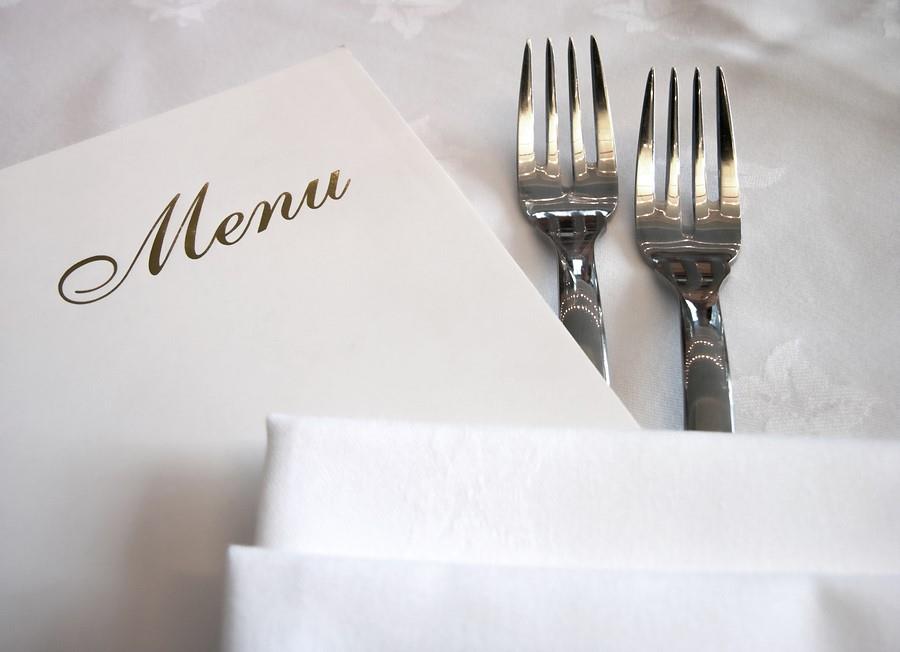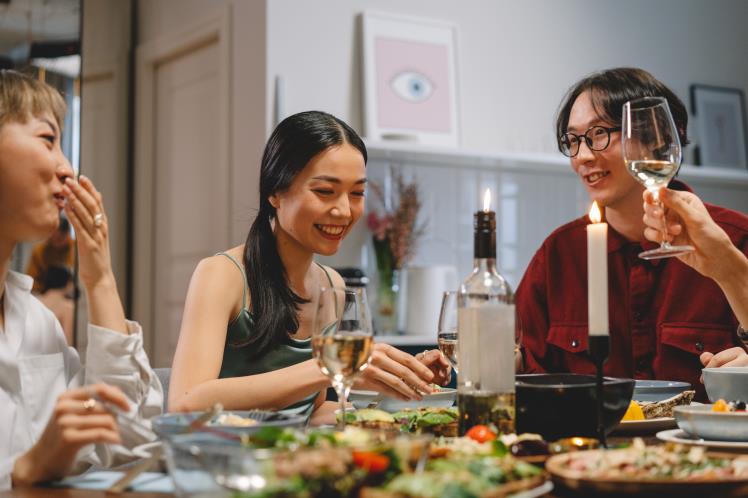This is the season for delicious meals eaten with family and friends, catching up, and celebrating the festive seasons. When visiting someone else home, or being invited to a restaurant for a special evening meal, or a date night out, do you know all the dos and don’ts and all the basic etiquette guidelines?

Simple Etiquette Guidelines for dining at Home, while visiting, being invited to a restaurant, or having a date night out.
It’s easy to forget some baseline etiquette guidelines, so, we’re here to prepare you to avoid common dinner table faux pas. Whether you are hosting a meal or are invited to one, the way we choose to behave while we dine reveals a lot about ourselves, our attitude, and it highly affects the way others perceive us. Good table manners, as well as dining etiquette, are essential qualities for every elegant man and woman.

What are dining etiquette and manners?
Dining etiquette and table manners are basic rules for behaviour around the table. The way we eat, the way we sit, the way we treat others, and even the type of conversations we hold are all part of table etiquette and manners.
Why do we need to have good table manners?
“Table manners”? You may say,” are they important?
And you may be thinking, “don’t knowledge, skills, contacts, and dressing count more”? Remember that lack of table manners is simply an indication of your level of sophistication, your upbringing, and on the whole, puts you in a poor perspective.
Etiquette and manners are timeless, and they are useful skills to learn for any social or business occasion. Whether you are dining with family members, friends, coworkers, clients, – good table manners define your elegance and class. Good table etiquette helps to put you on the right foot with those around us and make them feel comfortable; they set basic rules such as eating with our mouth closed or not using our cell phone since these actions can cause inconvenience to those at the table.
It is courteous to RSVP to the event you’re attending as soon as you know if you’re able to attend.
Top 10 basic International Table and Dining Etiquette Tips around the world.
It is important to know that expected dining etiquette can vary considerably in countries and cultures around the world. Different cultures have different norms and rules. On the table, no matter which country the people come from, they could feel the respect fom the table manners.
“When it comes to eating, you can sometimes help yourself more by helping yourself less.”
Before the Meal
1. Where to sit?
If you are invited to a lunch or a dinner, wait for your host to indicate who should sit where. If you are the host, ensure that ladies and gentlemen sit in alternate places (not all men together). The group should sit down altogether, not immediately after one is allocated one’s seat. Men should assist the ladies next to them by pulling out their chairs. The host should signal that all can be seated, after indicating their seating.

Always introduce yourself to others seated at your table
2. Respect Personal Space.
Keep your elbows as close to your side as possible and keep personal items (including smartphones) off the table. To avoid collisions at the dinner table, always enter your seat from the left-hand side and exit on the right. If you need to use the restroom during the meal, never announce your intentions to the group. Just say, “Excuse me,” and step away.
During the Meal
3. Napkin Etiquette
After sitting at the table, immediately open the napkin and place it on your lap. Work to develop the habit, use the napkin to delicately blot your lips after water, or food. If leaving the table temporarily, put the napkin (unfolded, but gathered together) on the chair. It says you are not finished with your meal and ensures that your plate will not be taken away. Don’t wipe your face with it or blow your nose into it or scrub your arms with it (use your handkerchief instead).

4. Understand the Table Settings
FORMAL: The first requisite of good table manners is to become familiar with the table settings, particularly in restaurants where meals are served in courses, i.e. various dishes are brought to the table in a sequence, and different plates, silverware, and glassware are used for each course.
Three-course dinners are commonly served on formal occasions today. At even the most formal dinner which is a five-course or seven–course dinner, you will not be confronted with more than three forks, on either side of the dinner plate at a time. If any more silverware is required, it will be brought in with various courses. The exception is the oyster (or seafood) fork, which may be placed to the right of the last spoon (even when it is the fourth utensil) to the right of the plate. The initial typical formal meal should look like this.

Easy Rule of Thumb governs the order in which the forks and knives are to be used. Start from the outside and work your way inwards.
INFORMAL: At an informal dinner, all silverware is laid on the table at one time. At the host’s option, the dessert utensils maybe brought to the table on a dessert plate. The following is a standard setting for a three-course meal.

CASUAL: In a CASUAL meal, say at a friend’s or family member’s house, usually just one spoon, fork and knife are used.
The knife may or may not be present. In South East Asia, there is normally a rice spoon. The rice spoon is placed on the right side of the plate, in place of or, in addition to the knife. In the latter case, the rice spoon is placed to the right of the knife. The fork will be placed on the left side of the plate.

If soup is there, a separate soup spoon (it is placed on the right side of the knife) is kept alongside the dinner spoon. The fork here is held in the left hand and the spoon in the right. The spoon is used for putting in your mouth and the fork is there to help in putting the food into the spoon.
5. Dining Etiquette – Hold your Utensils in the American or Continental (also called the European) Style of Eating
Wait until all guests or everyone is served, and the host begins eating before you begin eating. Be sensitive to the feelings of those around you and this rule applies to all dining occasions – whether you are dining with your significant other, family members, coworkers, clients, or friends. Always watch your host and/hostess for “cues” or instructions if you are unsure of what to do.
Cut with your knife in your right hand and your fork in your left hand. When dining with utensils, sit upright and bring foods or beverages to your face, not your face to your food or drinks.


Left: American Style of Resting and Finished Position
Right: Continental Style of Resting and Finished Position
A quick rule: from the moment that you have used your utensils, they should never touch the table again. When you pause to converse or to take a sip of your beverage during the meal, place your utensils in the ‘resting’ position, and when you’re finished eating, place them in the ‘finish’ position.
You can choose to place your utensils either in the CONTINENTAL or in the AMERICAN Style, whichever you are more comfortable with.
6. Proper “Passing” etiquette
The salt and pepper should always stay together. If someone asks you to pass the salt, always pass the pepper with it, and vice versa. When passing something at the table, say “excuse me” if you need to reach in front of someone to pick up and pass the item.
7. Bread Etiquette
Break off only one piece of bread, or roll, before buttering it or putting jams on it. Only butter one piece at a time, the piece you wish to eat, and it should be small enough to fit wholly into your mouth.
8. Be Mindful as you are eating
Chewing with your mouth closed is a basic rule of proper dining etiquette. Talk only after you swallow your food. The best way is to take small bites as you eat. That way, when someone addresses you, you can quickly finish your bite and respond.
9. Bring your BEST self to the meal. Take part in the dinner conversation.
Never slurp your drink loudly, stir your tea, tap utensils on your plate or cup, or wave your utensils about when talking.
After the meal
10. When finished eating, position your silverware
(as shown on item no. 5 above), to tell the server you are done. Fold your used napkin and place it to the LEFT of your place
THINGS TO REMEMBER.
DON’T
Never phone or talk on your phone while others are dining alongside you. If you must call or text, politely excuse yourself from the table to make the call or text.
- Never phone or talk on your phone while others are dining alongside you. If you must call or text, politely excuse yourself from the table to make the call or text.
- Don’t comment on the food if you do not like it, but just leave it on the place.
- Don’t groom yourself by combing your hair, or applying make-up at the table.
- It is alright to refuse food, as long as this is done politely, i.e. “No (pause), thank you very much” pleasantly and appreciatively with a smile, or “No, thank you though” or “I’m sorry, not for me.”
- Don’t chew ice cubes
- Don’t blow on your soup or hot food or beverages, just it’s time to cool.
DO
- Keep your hands on your lap and/keep elbows off the table.
- When you order, say “May I please….” Or “May I have…”
- Say “thank you” when you are served. It is not necessary to say thank you when food or plates are removed.
- Call the waiter with a hand gesture or say, “excuse me” when they are within earshot. Don’t clap your hands, snap your fingers or call out loud.
- Say something nice about the food: “Mary, this chicken is delicious”; “Aunty, I just love your chicken soup.”
- Cup a lemon wedge in your hand before squeezing it to avoid squirting anyone.
Remember being socially savvy at the table is not just dinner, it’s business and relationship. Many interviews and business deals are conducted over a meal to observe each other’s comfort level in social situations. A relationship can be built or a job or business deal lost, over a simple spaghetti dinner or lunch. Are you prepared?
As Emily Post says,
“Manners are a sensitive awareness of the feeling of others. If you have that awareness, you have good manners, no matter what fork you use.”
When it comes to creating the perfect dining experience, ARTELIA owns a reputation that is second to none. As Luxury tableware that has evolved over four decades, ARTELIA caters to its elite customers bringing exclusivity and uniqueness to each meal on your table. From hosting a banquet to friends gathering, ARTELIA accompanied you with its finest brands in tableware, exquisite pieces, limited edition designs, or even the latest and most contemporary, to make your entertaining fun, memorable, with style and class.
To shop for luxury tableware elegant fine glass and silverware, and also decorative ornaments adorning corners of your interior, go to www.artelia.com.my
Date: 12th February 2022 (Saturday)
By: Teresa Dian Chew,
Principal Image Consultant, Chief Influencer and Author



